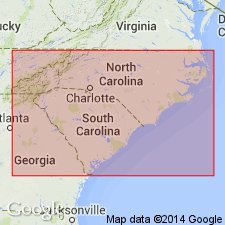
- Usage in publication:
-
- Moseley Creek Member
- Modifications:
-
- Named
- Dominant lithology:
-
- Sand
- Limestone
- AAPG geologic province:
-
- Atlantic Coast basin
Summary:
The Beaufort Formation in the Albemarle embayment of NC consists of the lower Jericho Run Member and the upper Moseley Creek Member, formally named in this report. Holotype for the Moseley Creek designated as the section of Beaufort Formation described by Harris and Baum (1977). The two members are recognized in outliers in the upper part of the middle Coastal Plain and are separated from the main body of Paleocene strata that occurs in the subsurface in the outer part of the Coastal Plain. The Moseley Creek Member consists of 3 to 4 m of alternating, unconsolidated, sandy, foraminiferal-glauconitic sediments and thinner, slightly glauconitic, foraminiferal biosparite and sandy biosparite. Unit is correlated to a 40-m-thick sequence of sand, and silty clay in the subsurface of the outer Coastal Plain. The Moseley Creek has been assigned to planktonic foraminiferal zone P4 (Thanetian).
Source: GNU records (USGS DDS-6; Reston GNULEX).
For more information, please contact Nancy Stamm, Geologic Names Committee Secretary.
Asterisk (*) indicates published by U.S. Geological Survey authors.
"No current usage" (†) implies that a name has been abandoned or has fallen into disuse. Former usage and, if known, replacement name given in parentheses ( ).
Slash (/) indicates name conflicts with nomenclatural guidelines (CSN, 1933; ACSN, 1961, 1970; NACSN, 1983, 2005, 2021). May be explained within brackets ([ ]).

